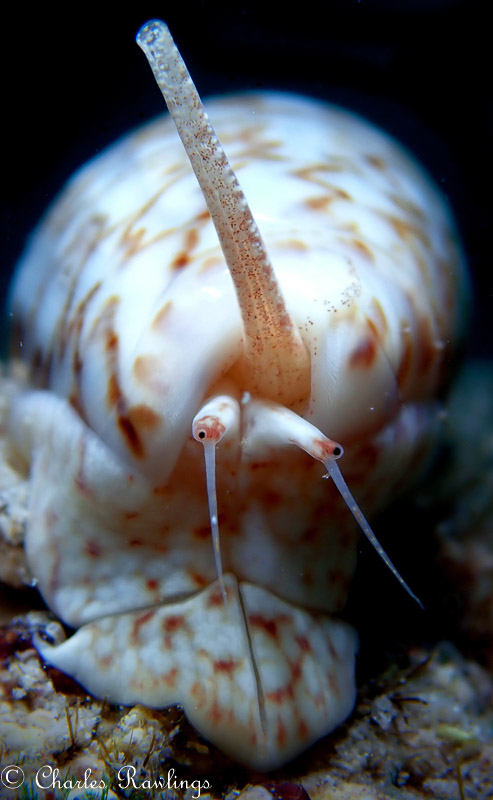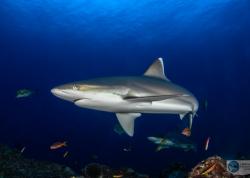La Paz Through a Mollusk Photographer's Lens
Editor’s Note: Charles Rawlings is a respected mollusk specialist who has published two books with his underwater photography. You can learn more about his latest offering at this link: Living Mollusks. His previous contribution to the guide was an engaging piece about using a TG-5 to supplement his DSLR rig. Charles looks at things from a different angle than much of the mainstream underwater photography community, making for engaging, interesting, and refreshing reading. I hope you enjoy! -Bryan Chu, Editor
La Paz, Mexico – these words, this place, conjures up visions of an arid desert wasteland spilling into a cerulean ocean. The famous or infamous Baja California adjoining the Sea of Cortez; Saguaro cactus meets whale shark. Jacques Cousteau once called the Sea of Cortez “the world’s aquarium” and the description is especially appropriate for the waters and dive sites around La Paz.
The dive sites around La Paz are well known for big animals – whale sharks, sea lions, dolphins, manta rays, mobula rays, huge schools of tuna and jack; even whales on occasion – Humpback whales, pilot whales, Sperm whales and rarely Blue whales. La Paz, while not really known for sharks, will also provide nurse sharks, bull sharks, white tip sharks and other sharks that draw divers in droves. But, what about the macro aspect of the La Paz diving fauna? Are there little creatures living on La Paz’s reefs and wrecks? I travelled to La Paz to see for myself; and found myself asking - what macro secrets would it reveal?

Crown of Thorns Starfish. Acanthaster planci. Swanee Reef. Nikon D80 with dual strobes, 60mm macro lens. 1/200 sec, f/22, ISO 100.
I am a specialist diver and photographer. I specialize in living mollusks, which include seashells, nudibranchs and cephalopods. Seashells are gastropods and bivalves such as oysters, clams, mussels and scallops. Cephalopods, meaning “head foot”, include nautilus, squid, octopus and cuttlefish; nudibranchs are those colorful “slugs”. The Sea of Cortez is renowned for its rich molluscan fauna, at least according to shell collectors. So, what could I discover and find diving around La Paz?
Diving Arrangements
I made arrangements with James Curtis and the amazing Cortez Club for a private boat and photographer – Nick Polanszky. I soon found out that Nick was a large animal photographer and a darn good one. Nick, however, is not a macro photographer guide, which he himself readily admits. However, his significant other, Natalia Siguerier, is a macro enthusiast. As a result, we all went hunting for mollusks and macro subjects. Our hunt was well rewarded at most dive sites.
I will not go over each day in detail but we ventured and dove each of the iconic La Paz dive sites including Swanee Reef, Isla Ballena, the Fang Ming Wreck, El Bajito and Isla Espiritu Santo. In addition to all the usual, classic dive sites around La Paz, Nick, Natalia, and I dove multiple unnamed coves and spots along the coast of Isla Espiritu Santo. I totally enjoyed the usual La Paz tourist dive sites but to be honest, the exploratory diving along Espiritu Santo was amazing.
Exploring Isla Espiritu Santo
For instance, the second day the weather was perfect – no wind, 80 degrees, flat calm water and perfect dive buddies – Nick and Natalia. Where should we go was the question? The answer, wherever it looked good along the coast of Isla Espiritu Santo. We dove three times that day – in whatever location looked good for macro. So what did we find?
The boat anchored in a cove surrounded by volcanic rocks which continued under the water. The sunshine caused the rays of light to penetrate the water, illuminating it with a moving array of optics, while the stillness of the cove was punctuated only by the cries of birds. A sea lion popped up in the still waters; we back rolled off the boat and were greeted with an amazing cacophony of macro life.

Where to begin? The oysters were scattered haphazardly across the bottom and on the cascading rocks from the cliffs above. The scallops were hidden amidst the rocks and under the coarse volcanic sand. The conchs, the Pacific Conch, one of the largest in the world, were moving along the bottom of the cove in the staccato haphazardly-flipping manner that only conch shells exhibit. In the sand were trails of moving shells and mounds marking the resting place of hidden gastropods that could be identified only after they were excavated. This was a macro photographer’s heaven.
El Bajito and Isla Ballena
The next day, we visited several of the named dive sites searching for nudibranchs – rare nudibranchs. With Natalia at my side, we were not disappointed. To begin the morning, we dove the Fang Ming wreck to investigate the possibility of a rare nudibranch and an unusual creature growing on several lines inside the wreck. We never found the rare nudibranch; the “unusual creature” turned out to be a very young juvenile oyster attached to a rope gently swaying with the surge inside the wreck. The photograph, while revealing, is not worth publishing. The wreck? The Fang Ming was awesome but macro it was not. So, off to El Bajito and then Isla Ballena; macro subjects abounded at each of these sites.
We pulled up and anchored at Isla Ballena where Natalia told me to keep my eyes open once we hit the bottom. No advice was better given. The site was an island wall that hit the sand around 60 feet and in a few spots several feet deeper. We immediately found several subjects including an unknown turrid and an amazing olive. Natalia has a great eye for macro subjects, and by teaching/showing her how gastropods moved under the sand she became an expert shell hunter – watching for the “sand that moves.” She found the olive while watching for the “sand that moves” while I found the turrid hunting amongst the algae tufts at the base of the rocks.

Sea Stars
While discussing the various macro areas, I must emphasize that each dive site contains macro subjects galore; that includes Los Islotes with the sea lions. I was especially fascinated with the various starfish, or sea stars to be accurate. I was definitely not aware that the Crown of Thorn starfish were a problem in La Paz. Evidently they are but whatever their status, they make amazing macro subject material. Other starfish are quite the unique subject as well.

One Last Day
The last day dawned bright, calm, warm and with promise of macro delights; well I should say the last day of macro photography. I must admit that I saved the last day to photograph sea lions with Nick.
The weather was perfect for cruising around Isla Espiritu Santo looking for sites. As we rounded the southeast corner, the topography changed. The cliffs led directly to the water, sloping gradually down to about 45 feet depth. The clarity was such that the bottom was visible and consisted of small pebbles and rocks interspersed with clumps of algae. Nick took the included photo while I was photographing a unique living cone at the site. The photo demonstrates the bottom as perfect for macro.

Both Natalia and I scoured the bottom for an hour discovering a multitude of subjects. My favorite, included here, was the Cone proboscis with harpoon.
Cone snails have always fascinated me, both from a photographic aspect and a neurological aspect. Cone snails are some of the most lethal creatures in the ocean. All cone shells are carnivorous, feeding on fish (piscivorous), feeding on worms (vermivorous), or feeding on mollusks (molluscivorous). I know what you’re thinking – wait, can snails really hunt down and kill swimming fish, or even worms? Yes, indeed they can, by utilizing a very potent, extremely fast acting combination of poisons that paralyzes and kills their prey in a matter of seconds. Some cones even have poison that can paralyze a human in less than 5 minutes!

So, what type of compound can do this? A conotoxin, which is a group of neurotoxic peptides (proteins). Each has a very specific action upon an ion channel, synaptic receptor, or even portions of the cell membrane. Whatever the action, conotoxins generally inhibit activity of muscle, physiologically destroying the integrity and coordination of the neural-muscular network, and thereby paralyzing their prey. (Editor’s note: that sounds fun!)
All cones are poisonous, although not all have the capacity to kill a human. The slurry of poisons found in each species in unique to that species only, and the composition of the poisons differs between individuals and varies in time – from day to day and from month to month. When viewing this photo keep in mind that all cones are deadly to some organism, but that their poisons may also hold the key to a multitude of neural diseases in the future, including pain control.
So, back to Isla Espiritu Santo. The site was a mecca for all types of unique macro subjects. We spent two dives there, and I vowed to do a night dive there the next time I visited La Paz. As we rounded the island and were making our way back to the dive shop, we were accompanied by a large pod of dolphins and spotted several blows from a Humpback whale. La Paz was reminding us of its large animal heritage.
La Paz is a magical place with its dive sites filled with wonder. From rocky reefs to sunken wrecks to unnamed coves to the classic sea lions of Los Islotes, La Paz has something for everyone. Although La Paz is best known for its whale sharks, mobulas, mantas and sea lions, it is also a haven for a fascinating array of macro life and photographic subjects. Next time you visit La Paz for the big animals, take a day of diving and search for its macro wonders with Natalia. You will not be disappointed.
Book your Sea of Cortez Trip!
Bluewater Travel can help you plan and book the perfect Sea of Cortez dive trip. Visit Bluewater's Sea of Cortez Scuba Diving page or email info@bluewaterdivetravel.com .
Bluewater is also offering the following Sea of Cortez group trips:
- 2019 Sea of Cortez Underwater Photo Workshops
- 2019 La Paz Photo Workshop
- 2019 Explore Baja Open Boat Trip
- 2020 Sea of Cortez Underwater Photo Workshops
- 2020 Explore Baja Underwater Photo Workshop
Gear Links
- Olympus Tough TG-5 Camera
- Olympus PT-058 Underwater Housing
- Olympus TG-5 Camera and Housing Bundle
- Sola 1200 Video Light
Additional Readings
RECOMMENDED ARTICLES
SUPPORT THE UNDERWATER PHOTOGRAPHY GUIDE:
The Best Service & Prices on u/w Photo Gear
 Visit Bluewater Photo & Video for all your underwater photography and video gear. Click, or call the team at (310) 633-5052 for expert advice!
Visit Bluewater Photo & Video for all your underwater photography and video gear. Click, or call the team at (310) 633-5052 for expert advice!
The Best Pricing, Service & Expert Advice to Book your Dive Trips
 Bluewater Travel is your full-service scuba travel agency. Let our expert advisers plan and book your next dive vacation. Run by divers, for divers.
Bluewater Travel is your full-service scuba travel agency. Let our expert advisers plan and book your next dive vacation. Run by divers, for divers.

































